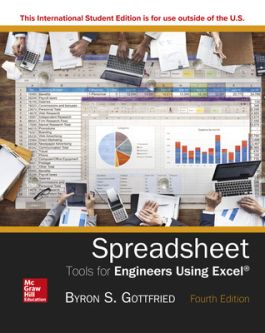Spreadsheet Tools for Engineers Using Excel ISE
4th Edition
1260290441
·
9781260290448
© 2019 | Published: January 2, 2018
This practical text is a perfect fit for introductory engineering courses as it successfully combines an introduction to Excel fundamentals with a clear presentation on how Excel can be used to solve common engineering problems. Updated to ensure com…
Read More
After purchasing your eBook, login to the McGraw Hill Bookshelf website and redeem the access code from your order confirmation email.
- Access your eBook online or offline
- Easily highlight and take notes
- Fully searchable content
- Syncs across platforms
NOTE: eBook purchase does not include Connect homework or adaptive SmartBook assignments
1. Engineering Analysis and Spreadsheets
2. Creating an Excel Worksheet
3. Editing an Excel Worksheet
4. Making Logical Decisions (IF-THEN-ELSE)
5. Graphing Data
6. Analyzing Data Statisically
7. Fitting Equations to Data
8. Sorting and Filtering Data
9. Transferring Data
10. Converting Units
11. Solving Single Equations
12. Solving Simultaneous Equations
13. Evaluating Integrals
14. Creating and Executing Macros and Functions
15. Comparing Economic Alternatives
16. Finding Optimum Solutions
Appendix
Index
This practical text is a perfect fit for introductory engineering courses as it successfully combines an introduction to Excel fundamentals with a clear presentation on how Excel can be used to solve common engineering problems. Updated to ensure compatibility with Excel 2016, Spreadsheet Tools provides beginner engineering students with a strong foundation in problem solving - with Excel as the modern day equivalent of the slide rule.
The book is intended primarily as a textbook for use in introductory engineering courses, although it may also be of interest to more advanced students and many practicing engineers.
The author provides plenty of background information on technical terms, and provides numerous examples illustrating both traditional and modern spreadsheet solutions for a variety of engineering problems. The first three chapters introduce the basics of problem solving and Excel fundamentals. Beyond that, the chapters are largely independent of one another. Topics covered include graphing data, unit conversions, data analysis, interpolation and curve fitting, solving equations, evaluating integrals, creating macros, and comparing economic alternatives.
The book is intended primarily as a textbook for use in introductory engineering courses, although it may also be of interest to more advanced students and many practicing engineers.
The author provides plenty of background information on technical terms, and provides numerous examples illustrating both traditional and modern spreadsheet solutions for a variety of engineering problems. The first three chapters introduce the basics of problem solving and Excel fundamentals. Beyond that, the chapters are largely independent of one another. Topics covered include graphing data, unit conversions, data analysis, interpolation and curve fitting, solving equations, evaluating integrals, creating macros, and comparing economic alternatives.

